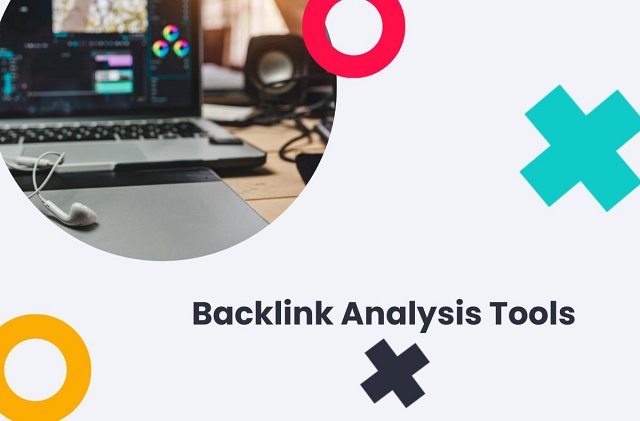(19 min. read)

Understanding Backlink Analysis Tools
Backlink analysis tools are specialized software designed to help website owners and digital marketers analyze their website's backlink profile. These tools provide valuable insights into the quantity and quality of backlinks pointing to a website, which is essential for improving search engine rankings. One of the core functions of link analysis tools is backlink analysis, which involves evaluating the strength and relevance of the links pointing to a website.
Backlink analysis is a crucial aspect of SEO, as search engines like Google consider the number and quality of backlinks as a significant ranking factor. High-quality backlinks from authoritative websites can improve a site's credibility and visibility in search results, while low-quality or spammy backlinks can negatively impact rankings and even lead to penalties.
How Backlinks Impact Search Engine Rankings
Search engines use backlinks as a key factor in determining a website's authority and relevance. When a reputable website links to your site, it's seen as a vote of confidence in your content. The more high-quality backlinks you have, the more likely search engines are to view your site as authoritative and trustworthy.
The Importance of Backlink Analysis Tools in SEO
Conducting a backlink analysis is essential for any website owner or digital marketer aiming to improve their site's search engine rankings. Backlink analysis tools play a crucial role in this process by providing valuable insights into the quality and quantity of a website's backlinks. These insights enable marketers to make informed decisions about their SEO strategy, ultimately leading to improved search engine rankings and online visibility.
There are several reasons why link analysis for SEO is so important:
- Identifying high-quality backlinks: By analyzing the backlink profile of a website, marketers can identify high-quality backlinks from authoritative sources. These backlinks can significantly boost a site's credibility and search engine rankings, making it essential to acquire and maintain them.
- Discovering low-quality or harmful backlinks: Backlink analysis tools can also help identify low-quality or spammy backlinks that may be negatively impacting a site's search engine rankings. By disavowing these harmful links, website owners can protect their site's reputation and avoid potential penalties from search engines.
- Uncovering link-building opportunities: Analyzing the backlink profile of a website can reveal potential link-building opportunities, such as guest posting on relevant blogs or collaborating with industry influencers. These opportunities can help improve a site's backlink profile and, ultimately, its search engine rankings.
- Monitoring competitors' backlink profiles: Link analysis for SEO also allows marketers to monitor the backlink profiles of their competitors. By understanding the strategies and tactics used by competitors, website owners can adapt their own SEO efforts to stay ahead in the competitive landscape.
Key Features of Backlink Analysis Tools
Backlink analysis tools offer a range of features that help digital marketers and website owners optimize their SEO strategies. In this section, we will discuss the key features of these tools, including advanced link analysis, and more.
Comprehensive Backlink Profile Overview
A crucial feature of backlink analysis tools is their ability to provide a detailed link analysis: an overview of a website's entire backlink profile. This comprehensive overview includes information on the total number of backlinks, the domains and URLs from which the backlinks originate, and the anchor texts used. Additionally, these tools offer insights into different link types (such as dofollow, nofollow, sponsored, and UGC links), the quality and authority of the linking websites, and the geographic distribution of the backlinks, showing which countries or regions the links are coming from. They also analyze the content of the linking pages, assessing relevance and context. By having access to this extensive data, website owners can better understand their site's backlink profile, identify high-quality links, spot potential issues, and pinpoint areas for improvement to enhance their SEO strategy effectively.
Competitor Backlink Analysis
Another essential feature of backlink analysis tools is competitive link analysis. This functionality allows users to analyze the backlink profiles of their competitors, providing insights into their link-building strategies and tactics. By understanding the strengths and weaknesses of their competitors' backlink profiles, website owners can adapt their own SEO efforts to stay ahead in the competitive landscape.
To gain insights from competitors' link building strategies, users can analyze factors such as the types of websites linking to competitors, the content that attracts backlinks, and the anchor text used. This information can be leveraged for link building by:
- Identifying potential link opportunities: Websites linking to multiple competitors may be more likely to link to your site as well.
- Content gap analysis: Determine what types of content are attracting backlinks for competitors and create similar or superior content.
- Outreach strategies: Use competitor backlink data to inform your outreach efforts, targeting websites that have shown interest in linking to similar content.
- Anchor text optimization: Analyze competitors' anchor text distribution to inform your own anchor text strategy while maintaining a natural profile.
Link Quality Evaluation
Backlink analysis tools also offer link quality analysis features, which help users evaluate the quality of their backlinks. This includes assessing the domain authority, page authority, and trust flow of the linking domains. High-quality backlinks from authoritative sources can significantly boost a site's credibility and search engine rankings, making it essential to acquire and maintain them. On the other hand, low-quality or spammy backlinks can negatively impact a site's rankings, so identifying and disavowing these harmful links is crucial for maintaining a healthy backlink profile.
Backlink analysis tools employ various methods to assess the quality and relevance of backlinks:
- Domain and Page Authority: Metrics that predict how well a page or domain will rank in search engines.
- Trust Flow and Citation Flow: Measures of trustworthiness and influence of linking domains.
- Relevance analysis: Evaluating the topical relevance of the linking page to your content.
- Link placement: Assessing whether links are placed naturally within content or in less valuable areas like footers or sidebars.
- Link velocity: Monitoring the rate at which a site acquires new backlinks, as sudden spikes can be suspicious.
- Diversity of linking domains: A varied backlink profile from different domains is generally considered healthier than many links from a few domains.
Top Backlink Analysis Tools for SEO
In this section, we will discuss some of the top backlink analysis tools available for SEO professionals and website owners. These tools offer advanced features and functionalities that enable users to conduct comprehensive backlink analysis, monitor their backlink profiles, and make informed SEO decisions.
Backlink Manager
WhitePress' Backlink Manager is a comprehensive tool for managing and analyzing backlinks. It allows users to import, segment, and track the history of links from multiple sources, report acquisition costs, and monitor publication statuses. This centralized management system streamlines workflow by consolidating all link data in one platform, enhancing efficiency and optimizing SEO strategies. It also includes features for financial control, ensuring better budget management and ROI evaluation in link-building activities.
Ahrefs
Ahrefs is a popular backlink analysis tool that provides a wealth of information about a website's backlink profile. With its extensive database of live backlinks, Ahrefs offers insights into the total number of backlinks, referring domains, and anchor texts. Additionally, it provides a comprehensive competitor analysis feature, allowing users to compare their backlink profiles with those of their competitors.
SEMrush
SEMrush is a comprehensive SEO tool that includes a sophisticated link analysis feature. It allows users to analyze their backlink profiles, identify toxic links, and conduct competitor backlink analysis. Its integration with Google Search Console provides additional insights, making it a versatile choice for SEO professionals.
Moz Link Explorer
Moz Pro is an all-in-one SEO suite that includes a powerful backlink analysis tool called Link Explorer. This tool provides users with a comprehensive overview of their backlink profile, including domain authority, page authority, and spam score. Moz Pro also offers a competitor analysis feature, allowing users to compare their backlink profiles with those of their competitors and identify opportunities for improvement.
Majestic SEO
Majestic is another powerful backlink analysis tool that focuses on link quality evaluation. It offers unique metrics such as Trust Flow and Citation Flow, which help users assess the quality and authority of their backlinks. Majestic's detailed backlink history feature enables tracking of backlink profile growth over time, providing a historical perspective on link-building efforts.
Linkody
Linkody is a user-friendly backlink analysis and monitoring tool suitable for both SEO professionals and beginners. It offers real-time backlink tracking, intuitive interface, and detailed metrics for each backlink. Linkody's key features include automated email alerts for backlink changes, competitor monitoring, and integration with Google Analytics and Search Console.
Ubersuggest
Ubersuggest, offers affordable backlink analysis features suitable for beginners. It provides content ideas based on backlink data and integrates well with other SEO metrics, making it a good starting point for those new to backlink analysis.
Buzzsumo
BuzzSumo, while primarily a content analysis tool, offers backlink analysis focused on content performance. It excels in influencer identification for outreach campaigns and provides content alerts for link-building opportunities, making it valuable for content-driven SEO strategies.
SEO SpyGlass (SEO PowerSuite)
SEO SpyGlass, part of the SEO PowerSuite, is a desktop-based tool offering unlimited backlink checks without API restrictions. It provides customizable reports and integrates well with other SEO PowerSuite tools, making it suitable for users who prefer desktop applications.
Cognitive SEO
Cognitive SEO is known for its visual approach to backlink analysis. It offers unnatural link detection and classification, providing a visual representation of backlink data. The tool also suggests content optimization based on backlink analysis, helping users improve their overall SEO strategy.
Monitor Backlinks
Monitor Backlinks is a dedicated backlink analysis tool that helps users keep track of their backlinks and identify any potential issues. It offers features such as link quality evaluation, competitor analysis, and integration with Google Analytics, providing users with a comprehensive understanding of their backlink profile and its impact on their SEO performance.
LinkResearchTools
LinkResearchTools is an advanced platform that aggregates link data from multiple sources. It provides detailed link classification and risk assessment, along with a Link Detox tool for identifying harmful links. Its competitive link juice analysis feature helps users understand their link profile in relation to competitors.
SE Ranking
SE Ranking offers a comprehensive SEO suite that includes backlink monitoring with daily updates. It provides white-label reporting, making it suitable for agencies. The backlink gap analysis tool helps identify link-building opportunities based on competitor data.
Raven Tools
Raven Tools is an all-in-one SEO platform that offers automated reporting for backlink profiles. It integrates well with Google Analytics and Search Console, providing a holistic view of a site's performance. Its Research Central feature is particularly useful for competitive backlink research.
Serpstat
Serpstat is a growth hacking tool that provides backlink analysis with historical data. It offers referring domains comparison and unique InLink Rank metrics for both pages and domains. Serpstat integrates backlink data with other SEO and PPC tools, providing a comprehensive digital marketing solution.
SpyFu
SpyFu, known for competitive analysis, offers insights into competitors' backlink profiles and historical data on backlink acquisition. It's particularly useful for building outreach lists based on competitor backlinks and integrates well with AdWords data for a broader marketing perspective.
Whitespark
Whitespark focuses on local SEO, offering a local citation finder tool and backlink analysis tailored for local businesses. It integrates review management and rank tracking with local search results, making it invaluable for businesses with a local focus.
BuzzStream
Finally, BuzzStream specializes in link building outreach. It offers prospect discovery based on backlink data, relationship management for link building, and email outreach tools. Its team collaboration features make it particularly suitable for agencies managing multiple link-building campaigns.
How to Use Backlink Analysis Tools Effectively
To perform link analysis effectively, it's essential to understand how to use backlink analysis tools to their full potential. By following this guide, you can maximize the benefits of these tools and improve your website's SEO performance.
Begin by setting clear objectives for your link analysis. Are you looking to improve your website's overall backlink profile, identify and remove toxic links, or analyze your competitors' backlink strategies? Having clear objectives will help you focus on the most relevant data and make informed decisions.
Next, choose the right tool for your needs. As mentioned in the previous section, there are several backlink analysis tools available, each with unique features and functionalities. Select the tool that best aligns with your objectives and offers the data and insights you require to achieve your goals.
Once you've chosen a tool, start by analyzing your website's backlink profile. Look for patterns, trends, and potential issues, such as a high number of low-quality or spammy links. This analysis will help you identify areas for improvement and develop a targeted link-building strategy.
Pay close attention to the quality of your backlinks, as not all links are created equal. Use the link quality evaluation features provided by your chosen tool to assess the quality of your existing backlinks and identify potential link-building opportunities.
Conducting competitor analysis is another crucial step. Analyzing your competitors' backlink profiles can provide valuable insights into their strategies and help you identify opportunities for growth.
Monitoring and Maintaining Backlink Health
As you continue to use backlink analysis tools, it's important to regularly monitor and maintain your backlink health. Set up a routine to audit your backlink profile using your chosen tool. This will help you track new and lost backlinks, giving you a clear understanding of your link profile's dynamics over time.
Pay attention to the diversity of your referring domains. A healthy backlink profile should have links from a variety of relevant and authoritative sources. Additionally, keep an eye on your anchor text distribution to ensure it remains natural and doesn't appear manipulated. Set up alerts for sudden changes in your backlink profile, as these could indicate potential issues or opportunities that require your immediate attention.
Identifying and Addressing Toxic Backlinks
While building and maintaining a healthy backlink profile, it's equally important to identify and address toxic backlinks. Use your backlink analysis tool to identify potentially harmful links based on metrics like spam score or domain authority. Look for patterns in toxic links, such as those coming from low-quality directories or irrelevant websites.
When you identify toxic links, attempt to remove them by contacting the webmasters of the sites linking to you. If this proves unsuccessful, you may need to use Google's Disavow Tool as a last resort. This tool allows you to tell search engines to ignore specific harmful links. However, use it cautiously and only after other removal attempts have failed. Make sure to regularly review and update your disavow file to ensure it remains current and effective.
By following these strategies and maintaining a proactive approach, you can effectively use backlink analysis tools to improve your website's SEO performance, maintain a healthy backlink profile, and address potential issues before they impact your search engine rankings.
Integrating Backlink Analysis into Your SEO Strategy
Incorporating backlink analysis into your SEO strategy can greatly enhance your optimization efforts. By leveraging insights from backlink analysis, you can make data-driven decisions to improve your site's authority, relevance, and search engine rankings.
Backlink analysis provides a clear picture of your site's link profile health, helping you identify and address potential issues like toxic backlinks or unnatural link profiles. It also reveals opportunities for improvement by highlighting gaps in your link profile that, when filled, can boost your site's authority and topical relevance.
Analyzing competitor backlinks is another effective strategy. By examining the backlink profiles of top-ranking competitors, you can uncover valuable link sources and content strategies, informing your own content creation and outreach efforts to compete more effectively in search results.
Additionally, backlink analysis can guide your content strategy by revealing which types of content attract high-quality backlinks. This allows you to focus your content creation on formats and topics with the highest potential for earning valuable links, thereby improving your site's authority and search visibility.
To create an effective link building strategy based on your analysis results, consider the following tips:
- Identify your most linked content: Analyze which pages on your site attract the most high-quality backlinks. Use this information to create similar content or expand on these topics, increasing your chances of earning more valuable links.
- Target high-value link sources: Use your analysis to identify authoritative websites in your industry that frequently link out. Develop targeted outreach strategies to these sites, offering them valuable content or resources that align with their linking patterns.
- Capitalize on competitor gaps: Look for high-quality websites that link to your competitors but not to you. Create content that fills gaps or provides additional value, then reach out to these sites to suggest your resource as a valuable addition to their existing content.
- Leverage broken link building: Use your analysis tools to find broken links on relevant websites in your niche. Create content that replaces the missing resource, then reach out to site owners offering your content as a replacement for the broken link.
- Diversify your link profile: If your analysis reveals an over-reliance on certain types of links (e.g., blog comments or directory listings), focus on diversifying your link sources. Aim for a natural mix of link types, including editorial links, resource page links, and mentions in industry publications.
- Optimize anchor text distribution: Analyze your current anchor text profile and adjust your link building efforts to maintain a natural distribution. Avoid over-optimizing for specific keywords and aim for a mix of branded, naked URL, and naturally varied anchor texts.
- Focus on relevance: Use the insights from your analysis to target link opportunities from sites that are topically relevant to yours. Relevance is a key factor in link quality, so prioritize building relationships with sites in your niche or related industries.
By integrating these insights and strategies derived from backlink analysis into your SEO efforts, you can create a more targeted, effective approach to improving your site's search engine visibility. Remember that backlink analysis should be an ongoing process, allowing you to continually refine your strategy based on the latest data and trends in your link profile and those of your competitors.
Measuring Success with Backlink Analysis Tools
Effective backlink analysis involves setting clear, measurable goals and consistently evaluating the impact of your link-building efforts on your overall SEO performance. By establishing specific objectives, such as increasing referring domains or improving domain authority within a set timeframe, you can focus your strategy and track progress more effectively. To measure the true impact of your backlink acquisition, it's crucial to monitor changes in organic search traffic, keyword rankings, and conversion rates. These indicators provide valuable insights into how your backlink profile influences your site's visibility and user engagement.
With your goals set and a framework for measuring impact in place, you can make data-driven decisions to optimize your SEO strategy and achieve your desired goals. Delve into the key metrics that will guide your backlink analysis:
Backlink growth is a fundamental metric to track, as it shows the increase in the number of backlinks to your website over time. A steady growth in high-quality backlinks indicates that your link-building efforts are effective and contributing to your SEO performance. Alongside this, monitoring the number of referring domains is crucial, as a diverse range of unique domains linking to your website demonstrates credibility and authority to search engines.
Domain Authority (DA) and Page Authority (PA) are valuable metrics provided by tools like Moz to evaluate the strength and quality of your backlink profile. Higher DA and PA scores suggest a more authoritative and influential website, which can positively impact your search engine rankings. Additionally, analyzing the distribution of anchor texts in your backlinks is essential for maintaining a healthy backlink profile, as a diverse and natural distribution helps avoid over-optimization penalties from search engines.
Assessing link quality is another critical aspect of backlink analysis. This involves evaluating factors such as the referring domain's authority, relevance, and trustworthiness. High-quality backlinks contribute more significantly to your SEO performance than low-quality or spammy links, making this assessment crucial for refining your link-building strategy.
Finally, comparing your backlink profile with those of your competitors can reveal gaps and opportunities for growth. By understanding your competitors' backlink strategies, you can develop tactics to outperform them in search engine rankings and identify potential high-value link sources.
By consistently tracking these metrics and aligning them with your established goals, you can make informed decisions to improve your website's backlink profile and optimize your overall SEO strategy. This data-driven approach ensures that your link-building efforts contribute meaningfully to your site's visibility, authority, and success in search engine results.
FAQ Section
In this section, we will address some common questions about backlink analysis, providing insights into the frequency of backlink analysis, the role of link analysis in recovering from penalties, and the most important metrics to consider when evaluating the strength of a backlink.
How frequently should I conduct a backlink analysis for my website?
Conducting a backlink analysis should be a regular part of your SEO strategy. The frequency of link analysis depends on the size and nature of your website, as well as your industry and competition. For most websites, it is recommended to perform a backlink analysis at least once a month. However, if your website is in a highly competitive niche or you are actively engaged in link-building campaigns, you may want to conduct a link analysis more frequently, such as every two weeks or even weekly. Regularly monitoring your backlink profile will help you identify new opportunities, track your progress, and address any potential issues before they negatively impact your search engine rankings.
Can backlink analysis tools help in recovering from a Google penalty?
Yes, backlink analysis tools can play a crucial role in helping your website recover from a Google penalty. By using backlink analysis tools, you can identify and address harmful links by either removing them through Google Search Console or contacting the webmasters directly to request their removal. This cleanup process is crucial for demonstrating to Google that you are addressing the issues and working to comply with their guidelines. Backlink analysis can also help you understand the reasons behind the penalty, allowing you to make necessary changes to your link-building strategy and prevent future penalties.
What are the most important metrics to consider when evaluating the strength of a backlink?
The most important metrics to consider when evaluating the strength of a backlink include:
- Domain Authority (DA) and Page Authority (PA): These metrics, indicate the overall authority and influence of the referring domain and the specific page linking to your website. Higher DA and PA scores suggest a more valuable backlink.
- Relevance: The relevance of the referring domain and the content surrounding the backlink is crucial. A link from a website closely related to your niche or industry is more valuable than a link from an unrelated site.
- Trustworthiness: Assess the trustworthiness of the referring domain by considering factors such as its age, history, and reputation. Trustworthy websites are more likely to pass on valuable link equity to your site.
- Anchor text: The anchor text (the clickable text of the backlink) used in the backlink should be relevant and natural, without being spammy. A diverse and natural distribution of anchor texts is essential for a healthy backlink profile.
- Link placement: The position of the backlink on the referring page can impact its value. Links placed within the main content area, surrounded by relevant and informative text, are generally more valuable than links in footers or sidebars.
Considering these metrics helps ensure that the backlinks you are acquiring or analysing are beneficial for your SEO efforts.



